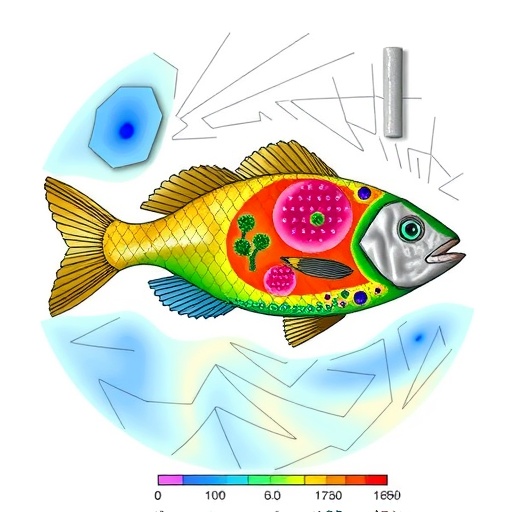In a groundbreaking study published in Commun Earth Environ, researchers Choi, Park, and Stock have shed light on the often-overlooked area of metabolic constraints that shape fish habitats. This insight is crucial, particularly as global climatic and environmental changes magnify the pressures on aquatic ecosystems. The research illustrates that fish habitats are not just determined by broad environmental factors but also by intricate metabolic limitations linked to the species of fish and their respective ecosystems.
Metabolic rates play an integral role in how fish interact with their environment. Just as other organisms rely on energy consumption and expenditure to thrive, fish use metabolic processes to navigate their habitats. The impact of temperature, salinity, and oxygen levels on fish metabolism underscores the urgency of understanding these factors as we work to preserve fish populations, which are vital for biodiversity and human consumption alike. This new perspective challenges previous assumptions that focused primarily on broader ecological parameters.
In the study, researchers employed advanced modeling techniques to extend the predictability of these metabolic constraints. The methodology integrated various ecological parameters to simulate how different fish species respond to environmental changes. By doing so, it allowed for a more nuanced understanding of fish habitats that could help predict future shifts, particularly in the wake of climate change. The ability to model these metabolic constraints could lead to more effective conservation strategies and enable stakeholders to proactively manage fish populations in various ecosystems.
The implications of these findings extend beyond scientific curiosity. Fisheries management and environmental policy are deeply impacted by the ways in which fish experience their habitats. For instance, if specific metabolic constraints are not considered, agencies tasked with managing fish stocks may overlook critical factors that determine the health and viability of those populations. This research thus advocates for policymakers to integrate metabolic data into their management frameworks, thereby promoting more sustainable practices.
Not only does this research offer insights into fish habitats, but it also raises awareness about the interconnectedness of life forms within aquatic ecosystems. The findings emphasize the complexity of these interrelations, suggesting that a singular focus on a few predator or prey species may overlook significant ecological dynamics at play. This holistic perspective is essential for fostering a vibrant and resilient aquatic habitat that can withstand the tests of changing climates and other anthropogenic impacts.
Furthermore, the study prompts a reevaluation of how we define ‘fish habitat.’ Traditionally, a habitat is viewed through the lens of physical and biological characteristics, but the findings indicate that metabolic efficiencies should also be included in this definition. As metabolic rates differ drastically among species, the habitat requirements could vary significantly even within the same ecological niche. Therefore, it becomes imperative for scientists and ecologists to adopt this expanded outlook when conducting habitat assessments in the future.
In addition, the research advocates for a collaborative approach among scientists, conservationists, and local communities. Engaging with those who directly interact with these aquatic ecosystems can enhance the implementation of findings from research. Communities can provide invaluable local knowledge, and in turn, the scientific community can offer insights on metabolic constraints that may lead to more effective local conservation strategies.
The work is especially pertinent considering the rise of global temperatures and the associated impacts on aquatic environments. With the oceans warming and oxygen levels depleting, the metabolic constraints identified in the study may become increasingly relevant. The research underscores the potential for fish species to experience new challenges as they adapt or migrate in response to these changes, highlighting the need for continual monitoring of fish habitats over time.
In conclusion, Choi, Park, and Stock’s groundbreaking research on metabolic constraints in fish habitats is not just an academic endeavor; it represents a call to action for scientists and policymakers alike. By redefining our understanding of what constitutes a fish habitat and recognizing metabolic factors as a key component, we can better protect these essential species. The future of aquatic ecosystems relies on our ability to adapt our strategies in line with scientific advancements and to collaborate across sectors to promote sustainability and resilience.
We stand at a critical juncture where profound changes need to be made, not only in how we manage fish populations but in how we perceive our responsibility towards the ecosystems that support them. The insights gleaned from this study serve as a beacon of hope, illuminating pathways to more effective conservation efforts that could ensure fish habitats thrive amidst the uncertainties of a changing world.
Subject of Research: Metabolic constraints on fish habitat
Article Title: Extended predictability of metabolic constraints on fish habitat
Article References:
Choi, HJ., Park, JY., Stock, C.A. et al. Extended predictability of metabolic constraints on fish habitat. Commun Earth Environ 6, 617 (2025). https://doi.org/10.1038/s43247-025-02600-x
Image Credits: AI Generated
DOI: 10.1038/s43247-025-02600-x
Keywords: Fish habitat, metabolic rates, ecological modeling, climate change, conservation strategies, aquatic ecosystems.




